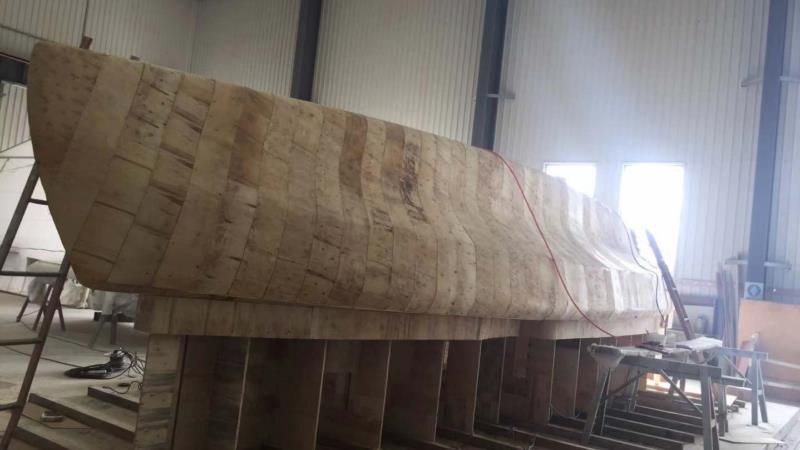
Corsair 880 trimaran Development Update 2
by Shane Grover, Corsair Marine 1 Jun 2019 10:25 UTC

Corsair 880 under construction © Corsair Marine
The beams of the 880 (or any folding trimaran) are under extremely high loads. Quite often, under loaded conditions the load on the beams will be 3 5x the total boat weight.
On the 880 the calculated max load on the beams is around 9,000kg. During the early design stages of the Corsair 880, composite strut attachments were investigated in line with our initial intention to move in this direction. Extensive weight analysis identified little to no weight gains by using composite attachments. Furthermore, the methods typically used for a composite attachment points actually hindered the folding geometry. Finally, given the results of our design testing, and our long and reliable history using aluminium bracket attachments, we have now identified the way forward is the aluminium brackets. Read more on the Design and development of the crucially-important beams in our Design Update #2.
Structural advancements
To manage and transfer the loads encountered when flying hulls, or even just in regular sailing conditions the beams have been designed with a centrally infused stringer. Using a technology developed for the rear targa arch of the Seawind Catamarans 1190 Sport model, this stringer is infused in one event as part of the infusion process of the upper and lower shells, to great effect in strength, weight, and durability. This advancement for the Corsair 880 is another case of transferring valuable technologies and know-how across brands, within the company.
880 Construction Update 1
With planking being added to the framework the 880 hull plug begins to take shape. The below images are really the first full size impressions of the hull and begin to show off some of her style ques, such as her slick reverse bows and chine lines. No details on folding or attachments yet, still a few more steps before we get to that stage.
What's in the beams
The beams of the 880, or any folding trimaran for that matter are under extremely high loads. Quite often under loaded conditions the load on the beams will be 3-5x the total boat weight. On the 880 the calculated max load on the beams is around 9,000kg.
Corsair has years of experience building beams, and we understand the loaded requirements under all points of sail. We also understand the importance for a practical outcome, including considerations such as a safe walking surface and the benefits of creating a deflecting underside profile to minimize spray on the nets and cockpit.
During the early design stages of the 880, composite strut attachments were investigated as it was our initial intend to go in this direction. Extensive weight analysis identified little to no weight gains by using composite attachments. Furthermore the methods typically used for a composite attachment point actually hindered the folding geometry. Finally, given the results of our design testing and the extensive successful history of aluminum bracket attachments we identified this was the only logical way to proceed.
The attachment method was another area of much review and consideration. Throughout our trimaran range we use two methods of fixing beams to floats. Method a) involves bolting the beam ends to the upper surface of the float, this method is typically seen on our models of 28' and under. Method b) incorporates an oversized beam end which is inserted inside of the float into a bulkhead and then glassed into place on arrival, you'll see this on the 31's, 970 and 37. Obviously method b is superior in strength, however is timely to assemble after delivery and somewhat permanent, making future shipments costly or difficult. Overcoming the weakness each of these options present for a boat of this size a hybrid solution was developed, providing both superior strength and ease of assembly. The solution incorporates a composite socket built into the float to accommodate each of the beams. The beams will be bolted in place however once under way the composite socket will actually do all the work of transferring the float loads onto the beams.
To manage and transfer the loads encountered when flying hulls, or even just in regular sailing conditions the beams have been designed with a centrally infused stringer. Using a technology found in the rear targa bar of Seawind Catamarans 1190 model, this stringer is infused in one hit as part of the infusion process of the upper and lower shells.
What is the Corsair 880? Learn More>>